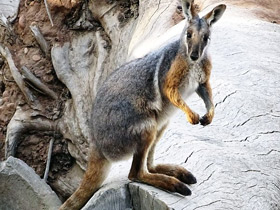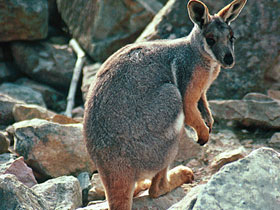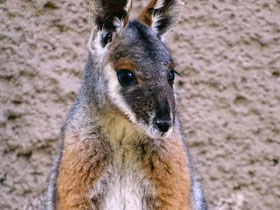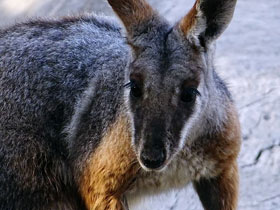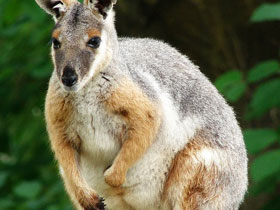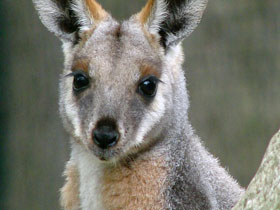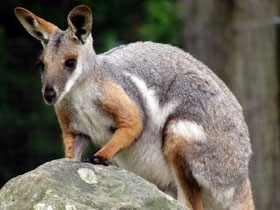The yellow-footed rock-wallaby (Petrogale xanthopus), the ring-tailed rock-wallaby
The yellow-footed rock-wallaby (Petrogale xanthopus), formerly known as the ring-tailed rock-wallaby, is a member of the macropod family (the marsupial family that includes the kangaroos, wallabies, tree-kangaroos, and wallaroos).
Appearance
Petrogale xanthopus is a species of marsupial diprotodontid in the family Macropodidae. Petrogale xanthopus is one of the most brightly coloured of the kangaroo species. It has a very thick and beautiful coat that keeps the animal warm in winter and away from heat in summer. The upper body of Petrogale xanthopus is greyish in colour, the belly and sides are white and the forelimbs and hind limbs are bright yellow; its tail is also yellow, and its entire length is varied by brown-black and red transverse stripes; its length varies from 57 to 70 cm. Petrogale xanthopus reaches a body length of 48-65 cm and weighs between 6 and 11 kg. The well-developed hind legs of Petrogale xanthopus are 12-17 cm long. Their soles are broad and the toes have long, sharp claws, allowing Petrogale xanthopus to stand out on rocks.
Conservation status and habitat area
Fortunately, hunting of the Petrogale xanthopus is illegal today, and only about 5,000 remain. Kangaroos have a small population in western New South Wales, and are present in small numbers in Queensland, eastern South Australia and north-western Victoria. For their beautiful fur, these kangaroos were captured and killed in large numbers.
Petrogale xanthopus is currently listed as vulnerable on the IUCN Red List. They prefer to stay away from humans and live in inaccessible rocky areas. The main threats to these animals are foxes and, above all, feral goats introduced by Europeans. Vegetation in the mountains is already sparse, and it is the goats that can compete with the Petrogale xanthopus for food. Interestingly, female Petrogale xanthopus are able to expel their young from their pouches during severe drought and with little food to survive in these conditions. In 1979, the National Parks and Wildlife Trust, an Australian conservation organisation, bought 100 square kilometres of land in New South Wales and established a reserve there, driving out all foxes and goats. This has paid off and, since 1995, the number of Petrogale xanthopus has steadily increased, giving hope for the conservation of the species.
Subspecies
There are two recognised subspecies. There are no observable differences between the two subspecies, but genetic analysis of DNA samples from the different populations found them to be genetically distinct. The genetic divergence between the subspecies is greater than that between some other rock-wallaby species, reinforcing the subspecies status.
The two subspecies are:
- Petrogale xanthopus xanthopus
- Petrogale xanthopus xanthopus is listed as vulnerable under the Environment Protection and Biodiversity Conservation Act 1999 by the Australian government. Colonies persist in South Australia, within the Gawler Ranges, the Flinders Ranges and the Olary Ranges. The population is SA is estimated at around 2,000 to 6,500 animals, with great uncertainty and likely large fluctuations. Due to conservation efforts by sanctuaries in the Flinders Ranges and pastoralists in the Olary Ranges, populations there have increased in recent years.
In NSW, colonies have been found at three sites in the Gap Range and seven sites in the Coturaundee Range, with a population of between 170 and 215 animals. Threats include competition from introduced herbivores (in particular feral goats and rabbits), predation by foxes and feral cats, isolation of populations, and habitat destruction through mineral exploration.
Petrogale xanthopus celeris
Petrogale xanthopus celeris is listed as vulnerable under the Environment Protection and Biodiversity Conservation Act 1999 by the Australian government. It has a restricted distribution in the rocky ranges of central-western Queensland. Threats include fox predation, competition with domestic and wild introduced species (particularly goats and cattle), climate change, reduced access to water sources, habitat loss and fragmentation, and increase in bushfires. The population of Petrogale xanthopus celeris was estimated to be 5,000-10,000 individuals in 1993, but is now considered unknown.

















